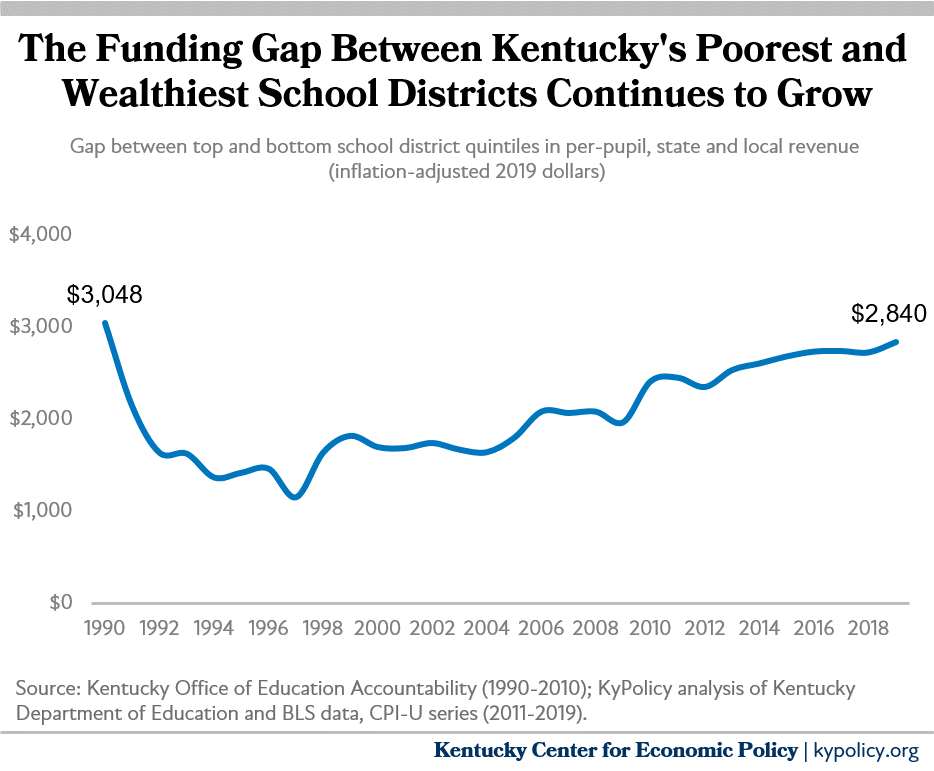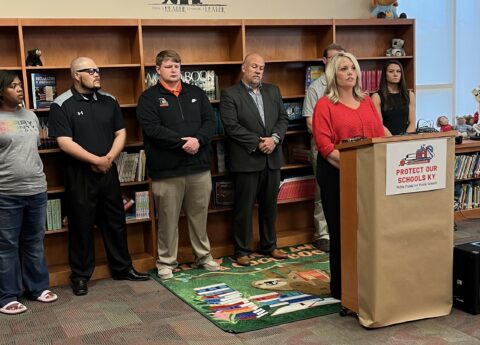As schools across the commonwealth face unprecedented new costs and challenges from a surging pandemic and historic recession, prior cuts in state core funding for K-12 education make the challenge even worse for Kentucky’s poorest districts. A new analysis from the Kentucky Center for Economic Policy shows the funding gap between wealthy and poor school districts continues to rise, climbing to levels not seen since before the 1990 Kentucky Education Reform Act (KERA).
The new KCEP research shows that wealthy districts had $2,840 more in state and local revenue per student than poor districts in the 2018/19 school year (the most recent for which data is available). The gap increased $122 in 2019 compared to the prior year, and is now just $208 shy of the pre-KERA gap in inflation-adjusted terms.

This gap is growing even as schools face new costs for distance learning and safe school operations including personal protective equipment; as the state and school districts anticipate deep tax revenue losses due to the unprecedented recession; and as families struggle with record-setting unemployment and rising food and housing insecurity — especially in low-income communities.
The drivers of growing inequity between rich and poor districts are inadequate state core funding for schools and an increasing reliance on local revenues, which create an advantage for students in wealthier communities. Even before COVID-19 hit, Kentucky ranked 4th-worst among states in core school funding cuts per student since the Great Recession. Now revenue shortfalls associated with the COVID-19 pandemic will likely stress both state and local investments in students, with potentially devastating impacts for students in poorer communities. In the short term, Kentucky needs much more in federal aid from Congress to prevent budget crises.
“Research shows that adequate and equitable school funding closes achievement gaps and boosts student outcomes. Kentucky was once on the frontlines of education reform that creates success for students no matter where they live,” KCEP Deputy Director and author of the analysis Anna Baumann said. “But we’ve been backsliding. As a result, we’re starting off the school year with the twin crises of a global pandemic and a level of inequity nearing what we as a state consider unconstitutional.”
According to the Center on Budget and Policy Priorities, federal aid provided to states in the COVID-19 pandemic thus far is sufficient to close just one-fifth of state revenue gaps. Education budget cuts caused by insufficient aid will magnify existing disparities and fall hardest on low-income students and students of color.
“Years of budget cuts have led to larger class sizes, outdated resources and technology, aging transportation and custodial equipment, reductions in classes like art, music, dance, agriculture and technology, and aging and crumbling infrastructure. And this was all before COVID-19,” Kentucky Education Association President Eddie Campbell said. Campbell is a teacher in Knox County, among the poorest 20% of Kentucky school districts. “Now, public schools are faced with additional costs related to COVID-19: transportation, technology, internet, cleaning, sanitizing, equipment for rooms and buildings and personal protective equipment.”
Though federal CARES act resources are already being used to address needs created by the pandemic, they are not enough to get districts through the school year. “It’s time for Congress to pass a no strings bill that provides all the funding necessary to stabilize our state,” Campbell said.
Kentucky superintendents in districts in the bottom quintile anticipate major challenges this school year if revenue shortfalls lead to another round of budget cuts.
“If budget cuts occur, what do we give up? The teacher providing reading interventions, a related arts teacher, or the counselor helping students prepare for college or future careers?” Green County Superintendent Will Hodges asked. “Funding within our district is a challenge during the best of times. During this pandemic, the fear that revenues could plummet is a worry to all districts but it is magnified for those districts that fall in the bottom quintile.”
Owsley County Superintendent Tim Bobrowski lifted up Extended School Services (ESS), transportation and food service as examples of “critical services that would suffer immensely” in another round of budget cuts. Furthermore, “local loss of jobs within the [school] system would affect the entire community,” Bobrowski said.
In the Dayton Independent school district, 85% of students qualify for Free and Reduced Lunch. “Our students need and deserve the same level playing field of opportunity and access as all children across Kentucky. An across the board cut would expose our most vulnerable children the most,” superintendent Jay Brewer said.
Among the possible consequences of another round of state budget cuts in his district, Brewer listed reverting to half-day instead of full-day Kindergarten, eliminating universal preschool, reductions in teaching and support staff including mental health counselors, increased class sizes and diminished learning opportunities, inability to remain current with instructional materials and to maintain or improve School Security and Safety expectations.
Floyd County could similarly face bigger class sizes and cuts to tutoring, ESS, student meals and “vital elective programs and even certain instructional programs that will affect students, especially those with learning disabilities,” Superintendent Danny Adkins said.
Superintendents also note the challenges students and families are facing at home because of the pandemic. To Bobrowski, “the affordability of high-speed internet access is a key … a necessity for all families.” Adkins is concerned that “students in eastern Kentucky are facing both device and connectivity issues.”
“Uncertainty of food, housing, and other essentials is a real concern for a growing population during this time. With time, the disparity between children will continue to grow. Our children are just as valuable and have as much potential as any child across the state,” Hodges said.
In May, the U.S. House passed the HEROES Act which included general fiscal relief to state and local governments that would have helped stabilize states’ education, health care and other budgets, as well as aid to families in the form of increased SNAP food assistance, extended supplemental unemployment insurance and rent relief. Last month the U.S. Senate went into recess without passing a relief bill.



